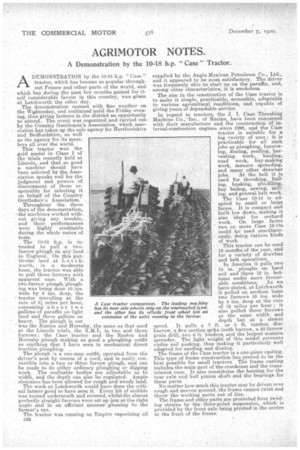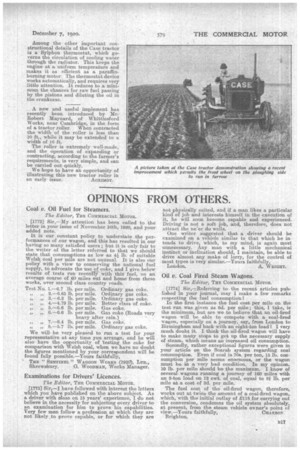AGRIMOTOR NOTES.
Page 26

Page 27

If you've noticed an error in this article please click here to report it so we can fix it.
A Demonstration by the 10-18 h.p. " Case " Tractor.
A. DEMONSTRATION by the 10-18 h.p. " Case " tractor, which has become so popular throughout France and other parts of the world, and which has during the past few months gained for itself considerable favour in this country, was ,gigen at Letchworth the other day.
The demonstration opened with fine weather on the W%driesclay, and continued untilthe Friday evening, thus giving farmers in the district an opportunity to attend.The event was organized and carried out by the Country Gentlemen's Association, 'which association has taken up the sole agency for Hertfordshire and Bedfordshire, as well as the agency for its mem-, bers all over the world.
This tractor won the gold medal in Class I of the trials recently held at Lincoln, and that so good a machine should have been selected by the Association speaks well for the judgment and powers ,of discernment of those responsible for selecting it on behalf of the Country Gentleilien's Association.
Throughout the three days of the demonstration, the machines worked without giving any trouble, • and their, performances were highly creditable during the whole series of tests.
. The 10-18 h.p. is intended to pull •a twofurrow plough on any land in England. On this particular land at Let c worth, in a moderate loam, the tractor Was able
• to pull three furrows with apparent ease. With a two-furrow plough, ploughing was being done 10 ins. wide by 8 ins, deep, the tractor travelling at the rate of 31, miles per hour, consuming 19, bout two gallons of paraffin on light land and three gallons on heavy. The plough in use was the Ruston and Hornsby, the same as that used at the Lincoln trials, the X.M.L. in two and three furrows ; the Case tractor and the Ruston and Hornsby plough making as good a ploughing outfit as anything that I have seen in mechanical direct traction ploughing. _ The plough is a one-man outfit, operated from the driver's seat by means of a cord, and is easily convertible into a two or three furrow plough, and can be made to do either ordinary ploughing or digging work. The malleable bodies are adjustable as to width, and the depth can also be regulated. Ample clearance has been allowed for rough and weedy land. The work at Letchworth would have done the critical farmer good to have seen it. Every bit of istubble was turned underneath and covered, whilst the almost perfectly straight furrows were set up just at the right angle and in an efficient manner . pleasing to the farmer's eye.
The tractor was running on Empire Paporizing oil c32 A Case tractor compariso has its near side wheels on and the other has its of extension of the axle) supplied by the Anglo-Mexican Petroleum Co., Ltd., and it appeared to be most satisfactory. The driver was frequently able to start upon the paraffin, and, among other characteristics, it is smokeless.
The aim in the construction of the Case tractor' is to make it simple, practicable, accessible, adaptable to various agricultural conditions, and capable of giving years of dependable service.
In regard to tractors, the Y. I. Case Threshing Machine Co., Inc., of Racine, have been concerned with their manufacture and the construction of internal-combustion engines since 1892, and the Case tractor is suitable for a big variety of uses ; it is practicable for all such jobs as ploughing, harrowing, discing, seeding, harvesting work,,, hauling, road work, hay-making work, manure spreading, and many other drawbar jobs. At the belt it is used for threshing, hulling, husking, sib-filmn hay baling, sawing, mi ing, and general belt work.
The Case 10-18 is adapted to small or large farms. It is compact and built low down, making it also ideal for orchard work. On large farms two or more Case 10 18s could be used simultaneously, doing various kinds of work.
This tractor can be used 12 months of the year, and for a variety of drawbar and belt operations.
In America it pulls two 14 in. ploughs on hard soil and three 12 in. bottoms under more favourable conditions, As we have stated, at Letchworth it pulled on medium loam two furrows 10 ins, wide by 8 ins, deep at the rate of 21 miles per hour ; it also pulled three furrows at the same width and • depth but at a slower speed. It pulls a 7 ft. or 8 ft. tandem disc harrow, a five section spike tooth harrow, a 22 furrow grain drill, two 6 ft. binders, and the largest manure
• spreader. The light weight of this model prevents rndue soil packing, thus making it particularly well adapted for seeding and discing. The frame of the Case tractor is a one-piece casting. This type of frame construction has proved to be the best possible for small tractors. The frame casting includes the main part of the crankcase and the transmission case. It also constitutes the housing for the rear axle and bull pinion shaft and the bearings for these parts. No matter how much this tractor may be driven over rough and uneven ground, the frame cannot twist and throw the working parts out of line. The frame and other parts are protected from twisting strains by the three-point suspension, which is provided by the front axle being pivoted in the centre at the front of the frame. Among the other important constructional details of the Case tractor is a Sylphon thermostat, which governs the circulation of cooling water through the radiator. This keeps the engine at a uniform temPerature and makes it as efficient as a paraffinburning motor. The thermostat device works automatically, and requires very little attention. It reduces to a minimum the chances for raw fuel passing by the pistons and diluting the oil in the crankcase.
A new and useful implement has recently been introduced by Mr. Robert Maynard, of Whittlesford Works, near Cambridge, in the form of a tractor roller. When contracted the width -of the roller is less than 10 ft., while it may be extended to a width of 16 ft.
The roller is extremely well-made, and the operation of expanding or contracting, according to the farmer's requirements, is very simple, and can be carried out quickly. We hope to have an opportunity of illustrating this new tractor roller in
an early issue. AGRIMOT.






























